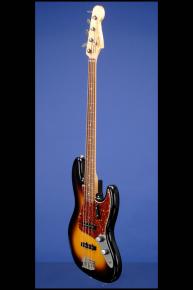John English's "Stack-Knob" Fender Jazz Bass
This was John English's personal Custom Shop 'Stack-Knob' reissue Jazz Bass. It conforms perfectly to an original 1960/61 guitar. This unique bass weighs just 8.10 lbs. and has a very narrow nut width (compared to the Precision Bass) of 1 1/2 inches and a scale length of 34 inches. Solid alder body, one-piece maple neck, and slab rosewood fretboard with 20 frets and white dot position markers. Headstock decal with "Fender" in gold with black trim. Beneath this is "Pat. 2,573,254 2,960,900 2,968,2044 / Des. 187,001". Beside this "JAZZ BASS / Trade Mark / ELECTRIC BASS" and beside that "OFFSET / Contour / Body". On the back of the headstock is a small oval gold decal "Custom Built / J.T. English / Fender U.S.A.". Single round string tree. Four-bolt neck plate with serial number "R13191" between the top two screws. Two black eight-polepiece pickups with outputs of 6.47k and 6.69k. Tortoiseshell over white/black/white plastic pickguard with beveled edges and eleven screws. Two concentric ("stacked") volume/tone controls and jack socket, all on metal plate adjoining pickguard (the two domed chrome volume knobs with knurled sides on top of the two black metal tone knobs with knurled sides). The potentiometers are stamped "019268 0024" (CTS, June 2000. With the original (black plastic) thumbrest on the treble side of the pickguard. Combined bridge/tailpiece with four individually adjustable deep-grooved 'spiral' steel saddles. The neck is signed on bottom in black ink "J. English / 03/14/01 / Custom Shop", and the neck pocket is also signed in black ink "J.T. English / 03/01". Complete with both of the chrome-plated bridge and pickup covers. Housed in the original G & G tan tolex hardshell case with brown leather ends and orange plush lining (9.25).
To the best of our knowledge we believe this to be the only Fender Custom Shop 'Master-built' Jazz Bass with all of the correct 1960/61 features. It was apparently the prototype for a Custom Shop Master-Built reissue that never made it to production.
"After the introduction of the Jazzmaster in 1958, Fender needed an upscale model to augment the bass line. In 1960, Leo's new Jazz Bass borrowed the offset waist and part of the name from the Jazzmaster. It also featured a narrower neck width, which was faster playing than the Precision Bass" (J.W. Black and Albert Molinaro, The Fender Bass, p. 25).
The Jazz Bass was the second electric bass guitar created by Leo Fender. The Jazz Bass is distinct from the Precision Bass in that its tone is brighter and richer in the mid-range with less emphasis on the basic harmonic. Because of this, many bass players who want to be more 'forward' in the mix, including smaller bands such as
three-piece power trios, prefer the Jazz Bass. The sound of the Fender Jazz Bass has been fundamental in the development of signature sounds in many musical genres, such as funk, disco, blues, metal and jazz fusion.
This guitar came to us directly from the estate of John T. English and is complete with a letter of authenticity.
Senior Master Builder John English who passed away June 2007 at the early age of 57 was raised on ‘50s and ‘60s rock ’n’ roll. He joined Fender in 1970, working alongside company pioneers such as Freddie Tavares and Bill Carson, and was a driving force in the early days of the Fender Custom Shop, helping to define the creative environment that continues in the shop to this day. One of the original Custom Shop builders, he was internationally renowned for his custom, concept and art guitars. He was a guitarist, drummer and artist who worked in the United States and Europe, and was a true original whose creations used exotic woods, metals, plastics, stones and bone, and were inspired by music, art, architecture and nature. He built custom guitars for countless musicians and collectors, ranging from Eric Clapton to President George W. Bush. His collaboration with surf guitar king Dick Dale resulted in one of the first Fender Custom Shop signature model guitars; he created Fender’s first Japanese signature guitar with Michiya Haruhata, and his trio of concept guitars created with art phenomenon Shag caused quite a sensation at the 2003 NAMM show.
Translate:









